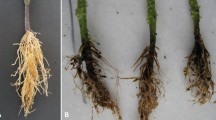Summary
Genes introduced into cultivated plants by backcross breeding programs are flanked by introgressed segments of DNA derived from the donor parent. This phenomenon is known as linkage drag and is frequently thought to affect traits other than the one originally targeted. The Tm-2 gene of Lycopersicon peruvianum, which confers resistance to tobacco mosaic virus, was introduced into several different tomato cultivars (L. esculentum) by repeated backcrossing. We have measured the sizes of the introgressed segments flanking the Tm-2 locus in several of these cultivars using a high density map of restriction fragment length polymorphic (RFLP) markers. The smallest introgressed segment is estimated to be 4 cM in length, while the longest is over 51 cM in length and contains the entire short arm of chromosome 9. Additionally, RFLP analysis was performed on remnant seed from different intermediate generations corresponding to two different backcross breeding programs for TMV resistance. The results reveal that plants containing desirable recombination near the resistance gene were rarely selected during backcrossing and, as a result, the backcross breeding method was largely ineffective in reducing the size of linked DNA around the resistance gene. We propose that, by monitoring recombination around genes of interest with linked RFLP markers, one can quickly and efficiently reduce the amount of linkage drag associated with introgression. Using such a procedure, it is estimated that an introgressed segment can be obtained in two generations that is as small as that which would otherwise require 100 backcross generations without RFLP selection.
Similar content being viewed by others
References
Alexander LJ (1963) Host-pathogen dynamics of tobacco mosaic virus on tomato. Phytopathology 61:611–617
Apuya NR, Frazier BL, Keim P, Roth J, Lark KG (1988) Restriction fragment length polymorphisms as genetic markers in soybean, Glycine max (L.) merrill. Theor Appl Genet 75:889–901
Bernatzky R, Tanksley SD (1986) Toward a saturated linkage map in tomato based on isozymes and random cDNA sequences. Genetics 112:887–898
Briggs FN, Knowles PF (1967) Introduction to Plant Breeding. Reinhold, New York, pp 164–165
Burton DW (1950) Pachytene morphology of the tomato chromosome complement. Am J Bot 37:639–643
Feinberg AP, Vogelstein B (1983) A technique for radio-labeling DNA restriction fragments to high specific activity. Anal Biochem 132:6–13
Hanson WD (1959) Early generation analysis of lengths of heterozygous chromosome segments around a locus held heterozygous with backcrossing or selfing. Genetics 44:833–837
Helentjaris T, Slocum M, Wright S, Schaefer A, Neinhuis J (1986) Construction of genetic linkage maps in maize and tomato using restiction fragment length polymorphisms. Theor Appl Genet 72:761–769
Landry BS, Kesseli RV, Farrara B, Michelmore RW (1987) A genetic map of lettuce (Latuca sativa L.) with restriction fragment length polymorphism, isozyme, disease resistance and morphological markers. Genetics 116:331–337
McCouch SR, Kochert G, Yu ZH, Wang ZY, Khush GS, Coffman WR, Tanksley ST (1988) Molecular mapping of rice chromosomes. Theor Appl Genet 76:815–829
Murray M, Thompson WF (1980) Rapid isolation of high molecular weight plant DNA. Nucleic Acids Res 8:4321–4325
Rick CM (1974) High soluble-solids content in large-fruited tomato lines derived from a wild green-fruited species. Hilgardia 42:493–510
Rick CM (1982) The potential of exotic germplasm for tomato improvement. In: Vasil IK, Scowcroft WR, Frey KJ (eds) Plant improvement and somatic cell genetics. Academic Press, New York, pp 1–28
Robinson RW, Provvidenti R, Schoeder WT (1970) A marker gene for tobacco mosaic resistance. Tomato Genet Coop Rep 20:55–56
Schroeder WT, Provvidenti R, Robinson RW (1967) Incubation temperature and virus strains important in evaluating tomato genotypes for tobacco mosaic virus reactions. Tomato Genet Coop Rep 18:29–30
Sharma HC, Gill BS (1983) Current status of wide hybridization in wheat. Euphytica 32:17–31
Southern E (1975) Detection of specific sequences among DNA fragments separated by gel electrophoresis. J Mol Biol 98:503–517
Stam P, Zeven C (1981) The theoretical proportion of the donor genome in near-isogenic lines of self-fertilizers bred by back-crossing. Euphytica 30:227–238
Tanksley SD, Rick CM (1980) Isozymic gene linkage map of the tomato: Applications in genetics and breeding. Theor Appl Genet 57:161–170
Tanksley SD, Miller JC, Paterson A, Bernatzsky R (1988) Molecular mapping of plant chromosomes. In: Gustafson JP, Appels R (eds) Chromosome structure and function. Plenum Press, New York, pp 157–173
Willimzig M (1985) LiCl-boiling method for plasmid minipreps. Trends Genet 1:158
Young ND, Tansley SD (1988) Restriction fragment length polymorphism maps and the concept of graphical genotypes. Theor Appl Genet 77:95–101
Young ND, Zamir D, Ganal M, Tanksley SD (1988) Use of isogenic lines and simultaneous probing to identify DNA markers tightly linked to the Tm2a gene in tomato. Genetics 120:579–585
Zeven AC, van Harten AM (1979) Proceedings of the conference, broadening the genetic base of crops. Pudoc, Wageningen
Zeven AC, Knott DR, Johnson R (1983) Investigation of linkage drag in near isogenic lines of wheat by testing for seedling reaction to races of stem rust, leaf rust and yellow rust. Euphytica 32:319–327
Author information
Authors and Affiliations
Additional information
Communicated by F. Salamini
Rights and permissions
About this article
Cite this article
Young, N.D., Tanksley, S.D. RFLP analysis of the size of chromosomal segments retained around the Tm-2 locus of tomato during backcross breeding. Theoret. Appl. Genetics 77, 353–359 (1989). https://doi.org/10.1007/BF00305828
Received:
Accepted:
Issue Date:
DOI: https://doi.org/10.1007/BF00305828




